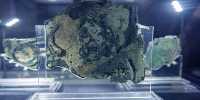Researchers describe one of the most unique late-Roman metalwares yet unearthed in the British Isles. Although the Knaresborough Hoard was discovered in 1864, no extensive investigation of the objects was conducted. The circumstances surrounding its findings were not entirely understood.
Jessica De Maso, a Newcastle University archaeology student, conducted the first detailed investigation of the treasure as part of her MA degree, and the findings were published in The Antiquaries Journal.
The majority of the 30 artifacts now on show at the Yorkshire Museum in York were presented to the museum in 1864 by Thomas Gott, an ironmonger who also served on the Town Council and lived in Knaresborough. However, he was hesitant to reveal where they were discovered or who owned the land.
Jessica and colleagues at Newcastle University believe the trove was discovered in a bog near Farnham, in the Vale of Mowbray, around two miles north of Knaresborough. During the Roman time, two key Roman roads went through the Vale: Cade’s Road on the east, which ran north-south, and Dere Street on the west, which was a significant route between York and Hadrian’s Wall.

Because of these links, there were several opulent Roman villas in the area, and the items in the collection are likely to have come from one of these, as well as an aristocratic townhouse or village nearby.
The Knaresborough treasure is the only known late Roman treasure of this sort unearthed from a swamp or marsh in Britain.
It is unclear why the things were grouped and put in the bog, although there are examples from other parts of the Roman empire where this was done for ritual or spiritual purposes, or simply to conceal or render them irretrievable.
During their studies, the study team discovered evidence that there were more objects in the trove when it was discovered, but many of them had been melted down by accident in Gott’s foundry.
Re-visiting previous discoveries
The surviving collection is primarily made of bronze and includes a large fluted bowl (approximately 48 cm diameter) with a scalloped edge, which is more commonly found in gold or silver, and a bronze vessel handle with a unique rest to support it, both of which are the only known examples found in Britain, as well as several bowls, strainers, and oval plates.
According to the research team, several of the items were intended to wow visitors at the table when displaying or serving food, as polished bronze looked like gold and represented a certain amount of affluence.
By using a portable X-ray fluorescence study, the team was able to confirm the composition of historical alloys and revealed that many of the pieces in the collection also showed traces of ancient repairs, indicating that they were constructed from a valuable material.
James Gerrard, Professor of Roman Archaeology at Newcastle University, said, “This project has demonstrated the value of revisiting old discoveries, and we’re thrilled to have the opportunity to collaborate with the Yorkshire Museum to learn more about this extraordinary collection and who Thomas Gott was.
“It’s good to know that more than 150 years on, our research has helped tell a fascinating, if complex, part of the story about this remarkable discovery.”
Adam Parker, Curator of Archaeology at the Yorkshire Museum, stated, “The Knaresborough Hoard is an exceptional collection of Roman copper alloys that has been in the Yorkshire Museum’s collection for a long time.” The superb work done by Newcastle University has unlocked the research potential of these objects for the first time, allowing us to tell their story more fully.”
‘Old collections and new questions’
The study also revealed more about Thomas Gott and his participation in the discovery.
Gott married Mary Anne Drury, a widow from Scarborough, in 1848. Mary Anne died in 1860 at the age of 47, and the following year, Gott married Emma, his late wife’s sister, in London.
At the time, Gott was serving as Knaresborough Improvement Commissioner, and while the marriage of a widower to his sister-in-law was widely accepted, it was illegal, which may explain why it took place in London—where they could avoid scrutiny and reduce the risk that Gott’s reputation would be called into question.
The research team believes Gott knew Frederick Hartley, who was also on the Knaresborough Improvement Commission and served as the agent and estate manager for Sir Charles Slingsby’s holdings near Farnham. The investigation revealed that, in 1864, Slingsby commissioned work to improve drainage on a swampy area of his property, and that the trove was most likely discovered around this time.
Hartley kept one cup for himself or Slingsby and gave the remainder to Gott, who donated the majority of the collection to the Yorkshire Museum. Thirteen years later, Gott handed the Yorkshire Museum the second and final half of the collection.
In 2017, the Yorkshire Museum included the Knaresborough trove in its “Old Collections, New Questions” research initiative, and Jessica jumped at the opportunity to investigate the trove as part of her MA in Archaeology at Newcastle University.
Jessica, who is now an archaeologist in the United States, stated, “The study of the Knaresborough Hoard at the Yorkshire Museum was a fantastic opportunity to interact with the idea that countless lines of research may be conducted on existing collections in museums. This, along with my time at Newcastle, was particularly intriguing and demanding for me. The Hoard study, as well as the work I did throughout my MA archaeology program, have properly prepared me for my current position.
















